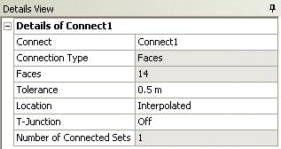The following properties allow you to control the behavior of the feature:
Location Property
A Location property is available for vertices, edges and faces that can be selected from the drop down list. Two options are provided. When set to Interpolated (default), all entities in a subset will be modified so that their new geometric location is computed as an average location. When set to Preserve First, the first entity in each subset will remain unchanged and all other entities in the subset will have their geometry modified so as to be coincident with the first entity. The order of coincident entities in a particular subset will correspond to the order of entity selection by the Apply/Cancel button property.
When using the Connect feature after Share Topology, the Location property is not available and is defaulted to preserve first.
T-Junction Property
A T-Junction property is available for both edge and face connect.
For edge connect, T-Junction property may be applicable when edge end-vertices, collected from the selected edges, are within the user-specified tolerance of the interior of one or more of the selected edges. T-junctions will not be detected when this property has a value of Off. If this property has a value of Interpolated, then an average location will be taken from the set of coincident vertices that are within tolerance of an edge interior and from the projection of this average location onto the edge interior. The final average location will become the new geometric location of the splitting vertices and the new vertex resulting from the edge split. If this property has a value of Preserve Split-Edge, then an average location will be taken from the set of coincident vertices that are within tolerance of an edge interior and this location will be projected onto the edge to split the edge (as with the Interpolated property value), but the final location of the splitting vertices and the new vertex resulting from the edge split will be the edge split location.
For face connect, the T-Junction property has a default value of Off meaning that only fully overlapping faces can be connected. For connecting partial overlapping faces, switch the property value to On.
Merge Bodies Property
Whether or not multiple line or Surface bodies are merged by a vertex or edge connect is controlled by a Merge Bodies property that may take values No, Yes, or If Compatible Attributes. A value of No indicates that multiple bodies will not be merged. A value of Yes indicates that multiple bodies may be merged if any associated subset of selected entities can be fused. A value of If Compatible Attributes indicates that line body or surface body attributes must be compatible in order for merging to take place. While line bodies may be non-manifold, surface (and Solid) bodies must remain manifold. For example, it is possible to fuse any number of vertices or edges from any number of line bodies. However, it is only possible for two laminar edges from one or two surface bodies to be fused. In this latter case, additional coincident edges will not be fused.
When using the Connect feature after Share Topology, the Merge Bodies property is not available.
Number of Connected Sets Property
The Number of Connected Sets property is available only for faces. This property will be visible only when the feature is in a generated state. This property will display the number of successfully connected face sets.
 | Details View indicating Number of Connected Sets for Face Connect |
When using the Connect feature after Share Topology, then Number of Connected Sets property is not a selectable option. Instead, resulting face connects are listed in detail. See Selective Shared Topology: Using Connect after Share Topology for more information.


